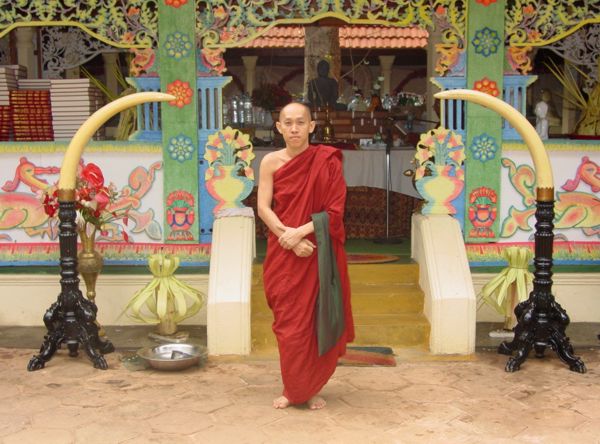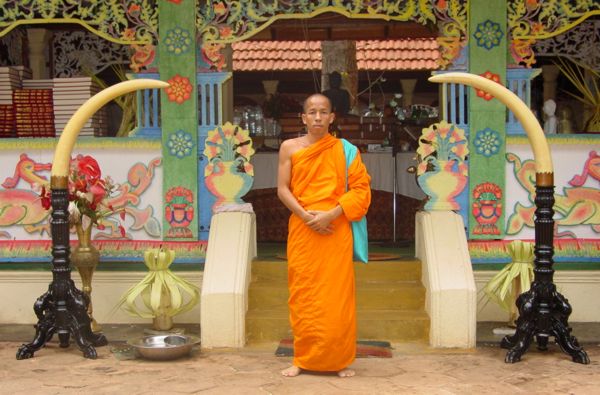84,000 Oil Lamps, June 20, 2006
One noteworthy thing about being so far away is that we lose track of people, unless they are determined to keep in touch. Of course, we know that lots of folks are very busy just making it through the week. Life in the US isn't easy, especially in Michigan, right now. That's why our most faithful correspondents are so special. You know who you are, and we appreciate it!
Ironically, one of best communicators we know has to do it entirely on a beaten up old electric typewriter, with fragile daisy wheels (the last letter was written entirely in caps for which he apologized, but the lower case were broken). We've known Calvin for some years now, and through him we've met a lot of other inmates and learned a bit about the US prison system. Calvin's letter took two months to reach us, but it reads fresh! We'd like to share it with you. Here it is in its entirety.
|
Dear Ken and Visakha,
Thank you so much for all the printed material you sent a while back. I also appreciated the postcards and your update letter. With all the turmoil in the world today, no one is really safe while in countries torn by strife. I hope and pray that your stay there will always be a peaceful and productive experience.
Recently our Sangha was told that our annual event could not be held in September but had to be held in May. All those whom we had invited a year earlier had to be contacted. We had only weeks to plan and submit the required proposal and even less time to raise the funds and re-invite guests who could come on short notice. Circumstances made it impossible to get together with our sponsors in time and the deadline loomed.
Instead of allowing everyone to get stressed out over something that is supposed to be a joyous occasion, I suggested to the Sangha that we have a simple, "Sangha Day"--A day where we celebrate our Sangha and each other. We plan to show the Vajra Sky film series if we can get them before the event. We will have meditation periods, put together a rice mandala, have a snack of bagels and nice cheeses, cake and juice, and if any guests show up they can participate with Dharma talks. But, the thing that has caused the biggest stir was when I announced that I needed eight volunteers from the Sangha to give teachings of a presentation on the Eightfold Path. Nearly twenty guys lined up to volunteer! Some I assigned and others were picked. Since that night, I have been approached by several of the members who told me that they had no idea how much there was to the Eightfold Path. The Sangha Member who was assigned "Right View" walked around the yard with me last weekend and told me with a broken voice that through his preparation for the talk he discovered that he never really had a right view. The revelation was a shock to him and he thanked me profusely for giving him the opportunity to deepen his practice. A lumbering, tall, and often forgetful young man picked, "Right Mindfulness" which was just the thing for him. He just stumbles through life doing many things and nothing at all. For months I tried various methods to help him focus and with his meditation practice, but always something interfered. Just this morning, as we walked back from breakfast, he said that his lack of mindfulness caused his mother to suffer and that he now saw, not just the importance of mindfulness but the connection mindfulness has to the other parts of the Eightfold Path. Another member passed me by yesterday and I asked how his project was coming. He stopped and shook his head, and said that I was pretty clever for having given him "Right Effort." Everyone feels that this is one of the best things that has happened to our Sangha. Those who do not have an "assignment" are now alternatives in case someone is transferred. They too will get a turn at teaching during our weekly practices after the event. We will continue this with weekly presentations. Even I am surprised by the response but very happy to see people so involved.
In addition, the many obstacles that we faced in the past ten years which usually were connected to the Chaplains in charge, have just about dissolved. The new chaplains and the associate superintendent are meeting with me regularly and helping establish a more liberal treatment of Buddhists. We get more practice time, items that are sent in just come in without heavy restrictions and we can have a monthly retreat or guest visit if we can arrange it. Huge changes. But all those grievances and legal maneuvers going back to 1996 were just now getting to court and the state did not want to face federal court with the pile of documentation we have. Instead, they moved the old chaplains out, installed new ones, and opened up dialogue. I am so happy to see this progress on every front.
Despite losing 10 core members since December 17th to release and transfers, we still have nearly 30 at the weekly practices. Nothing but positive news! With all that is happening around the world, I have no reason to complain. So, thank you for the support that helped make our accomplishments possible.
Now that I do not have to spend so much time dealing with legal issues, grievances, and problems relating to organized bias from prison officials, I now have more time for practice and writing. Believe me I am happy about that too!
I hope you are well and that your practice and your efforts are progressing too. Thank you again for all your support and attention all these years. It looks like we prevailed and those who wish to try Buddhist practice in Washington prisons can do so without hindrance.
Another small accomplishment is my mala project. I have made and donated over 200 malas to prisons in Washington, Montana, Oregon, Vermont, and New Hamshire. It started out when I realized that most in our Sangha could not afford the malas. After searching around for a couple of years or so, I found the wooded beads I needed and where to get the related material. My first few fell apart but eventually, I found the right combination to make a durable, attractive mala. A donor sent a little money and I was able to expand this to help other prisons with malas. It costs me about $3 to make a good 8 mm or 20 mm 109 bead mala which would normally retail for about $12. I have enough material to make about 60 more to supply a growing demand. The project is a work of mediation for me and a perfect replacement for fly tying which I stopped doing years ago. I just shipped out five malas each of black onyx and adventurine to fill an order. This is the first time someone asked to buy my malas and if it works out, it may be a way to continue this project. You may be able to see them at www.wildmind.org. This organization is run by Bodhipaksa who helps incarcerated Buddhists. Shane and I contributed to a book he is compiling about Buddhist prisoners. So, as you can see, my life is full and I appreciate my good fortune.
I wish you the very best in your new home!
(Signed) Calvin
|
The local SL newspapers are taking several tacks: either lamenting a dying craft or promoting job openings. Sri Lankan cinnamon export is in trouble because of the lack of skilled rollers. It seems that experienced workers are getting on in yers and not being replaced. The government has created an institute to train the workers, but it has been hard to attract applicants. It is very hard work, requiring one to sit on the floor for hours; there is no status; and to become really good, it takes 10 years! Still, if the pay is as good as it seems, why aren't young men (and women) choosing that instead of remaining idle or becoming, three-wheeler drivers? A good question.
At long last our friend Dushy, English professor at Colombo University, visited us in Kandy. It was a surprise trip-- her friend, a professor at Peradeniya U, announced that she had an extra train ticket, so how about it? Dushy could get away, so she sent us an email before going to bed, and then called us from the train. Unfortunately, the inter-city train schedule was off that day (work to rules strike perhaps?) At Fort Station they were told to run to catch it, but, once aboard, they sat for another hour before a wheel moved. At a major junction, after which the train begins its steep ascent to Kandy there was more messing around, as the train shunted back and forth on sidings, dropped a bogie, picked it up again, and generally got later and later. She arrived more than two hours late, whereas on all of our trips we were right on time, or even early.
Our visit, once she arrived, was really a treat. We happened to mention the 6 week-long chanting of the entire Buddhist Tipitaka that was going on at Subodharama, and she was keen to see that. We called a tuk-tuk, and off we went. The chanting was being done in a lovely decorated pavilion at the top of the hill, next to the pagoda. Its entrance was flanked by two enormous elephant tusks in teak wood stands. Two monks chanted at a time in two-hour sessions, systematically going through the suttas, vinaya, and abhidhamma, with the pile of texts to be read slowly diminishing as the finished pile grew. There were plenty of people there listening and meditating--women with little grandchildren who sometimes dozed or nibbled a biscuit, but who were remarkably unsquirmy. It was very peaceful, sitting there surrounded by bamboo and tropical trees with vines, creepers, and orchids all around, listening to the Pali, occasionally hearing words that we recognized. We returned home thoroughly refreshed.
|
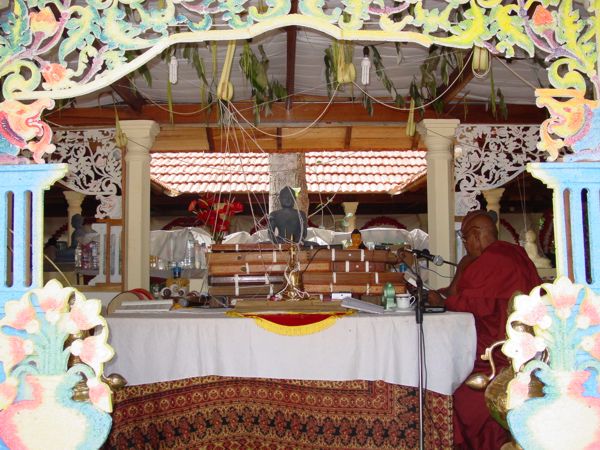 |
 |
|
|
 |
|
|
 |
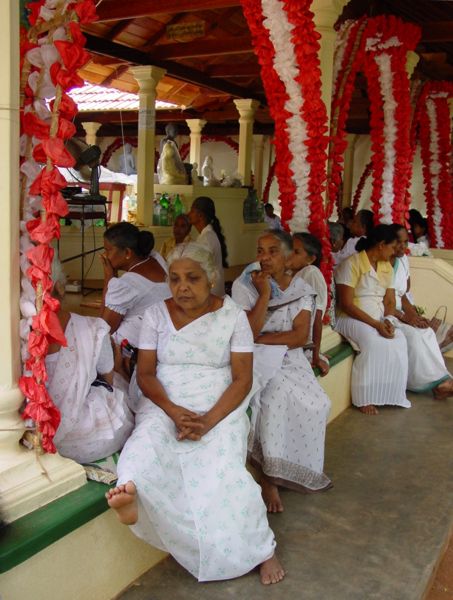 |
Above
Dushy and Visakha.
The pavillion around the Bodhi Tree where the monks chanted; from the front.
The pavillion from the side; the volumes on the right, in front of the white image of the Buddha, have been completed; those in the back are still to be chanted.
Below
The pavillion was always filled with devotees listening and meditating. |
|
|
|
|
|
|
|
|
|
|
|
We love company, and Lily, rose to the occasion with a delicious lunch, baked potatoes with cheese, various curries, salad, fruit, dessert, and tea. We caught up on Dushy's news and discussed the peace/war prospects. Sri Lankans have savored these past few years of relatively quiet cease fire, so there is real dread and angst at the prospect of full-scale hostilities again.
Dushy and Ken played "A Force More Powerful," the computer game that teaches non-violent strategies for social change. It's hard! Which means it's realistic, since effective social change is tough to accomplish. Although they had some small successes, ultimately they didn't manage to do what they'd set out to do. Still, nobody died in prison this time, so that's something. We're interested in learning how it works and how it is put together, thinking that it may be quite relevant to the game based on kamma, that we are trying to develop with Arjuna. More on that after we have met Arjuna again.
Talk shifted to our classes at Bodhisukha in Kolkata, and Dushy expressed interest in joining us to teach the next courses. Wow! When we mentioned our dream of developing a textbook for ESL intended for monks in particular and Buddhist learners in general, she said she'd like to be involved with that too. Double Wow! She's got her PhD from U of M and really knows her stuff, especially when it comes to materials development. So, we hope we're really in business after dreaming (and talking) about it for so long. Working with her in Kolkata would be terrific!
Shortly after Dushy left we got a surprise call from Ajahn Wisanu, who wanted to come up before leaving for Thailand and London, where he will reside in the Shan/Thai temple. He and Ven. Khemasara came up by bus in the evening. Ajahn finished his English Course at the British Council and had just received the results, which were what he needed to apply for a "Minister's visa." In Thailand, he hopes to be able to meditate with a much respected Shan monk on the border.
As always, we had a wonderful time having the two monks here. We meditated with them, served them breakfast and lunch, discussed Dhamma, and got updates on conditions in Shan State and northern Thailand.
Of course, we took them to Subodharama to meet Abbot Dhammawasa and to hear some of the Tipitaka recitation. Ajahn told us that, when he was in Buddhagaya earlier this year, there were three such recitations going on at the MahaBodhi temple, by Sinhalese monks, Burmese monks, and Thai monks.
Unbeknownst to us, the novices in our class at Vajiraramaya had gone to another temple for paritta (pirith, in Sinhala), The older monk was very apologetic. He had tried to call us the day before, but hadn't gotten through. Actually, it was fortunate that we went to the monastery that morning, for we were able to meet Ven. Dhammawansa, a monk visiting from Florida, whom we had met several years ago when he was visiting Michigan. Ven. Muditha had brought him to our house for lunch. We were delighted to have a chance to talk with and to learn about his temple in Florida. It seems that, when he first went to the US, he met six Americans who decided, as soon as they had met him, that they wanted him for their teacher. This group did all the paperwork for his visa and arranged an apartment to serve as a hermitage. When neighbors complained that there were too many cars trying to park there, especially on weekends, the minister from a nearby Unity church suggested his devotees buy a house next to the church and use the church parking lot. Now the temple has 80 members, and, for festivals, they alternate between the Unity Church and the Unitarian Church across the street. The ministers and members of both churches are very open and interested in meditation. Even one of the policemen in the town is Buddhist. Ven. Dhammawansa regularly visits high schools to talk to the students about Buddhism. One student, after hearing his lecture, bought some Buddhist books at Barnes and Noble and converted her family.
Sunday, June 11, was the full-moon of Poson, that's the commemoration of Ven. Mahinda's arrival in the Island, bringing Buddhism from India. Subodharama was planning an extravaganza--a perahera (procession) at three o'clock and a lighting of oil lamps at six. On our several visits to the monastery to hear the chanting, we had seen the bamboo shelves set up for the lamps on the hillsides, so we were eager to see the lamps. Barbara, who was staying in the meditation center there, had told us that the goal was 84,000 lamps!
Everyone in our compound wanted to go, so we contracted Chanda, the driver who took us to the Cultural Triangle, for the day. Never having seen a perahera in Sri Lanka (We are gearing up and getting excited about the Esala Perahera in Kandy in August, which is the grand-daddy of them all. That will be a major report.), we had no idea what to expect. There were only four of us, including Lily and Mrs. Munasinghe, Savithri's sister, whose name is Manel (not to be confused with Savithri's husband, whose name is also Manel). We found a comfortable spot near Subodharama, beside the street, at the foot of a hillside, where a path led up to up to another monastery, and waited. Just as we arrived, a band of children, dressed in Kandyan outfits, some with headdresses and some with drums, came down the path and headed for Subodharama. A few minutes later, we heard the drummers coming back, led by a pick-up truck in which were seated several novices, some of our students. In addition to the drummers, there were many laypeople clad in white; in one group, each woman was carrying a single pink lotus bud. One group of children carried a canopy of streamers in the six colors of the International Buddhist Flag. There were young girls performing a dance with sticks which they beat together, much as in the West, two children cooperate to clap "Patty-cake" or "I am a little Dutchgirl." The boys with the headdress and dhoti (Kandyan style, which Ken wants to learn to wear) also performed a classical dance. Ven. Dhammavasa walked solemnly along with all the other monks and novices, right behind another pickup truck bearing a statue of Ven. Mahinda. We learned that this was the first year for the Peradeniya Perahera, so we were not surprised that there was only one elephant, beautifully, though not too richly, caparisoned exactly like the one in the Vesak lantern in Kandy , but without the reliquary on his back. It was a delightful, down-home-style, perahera. Everyone enjoyed it, and there were not the teeming crowds one gets for the big ones. Several policemen marched in the procession to "keep the peace," but the traffic going in the opposite direction never stopped. It only took about thirty minutes for the entire procession to pass by. We debated for a few minutes whether we should wait for it to come back. We quickly realized, however, that given the route they were taking, it might be at least an hour before they returned. We opted to go home for lunch and to return, as we had planned, with the whole group for the lamp-lighting.
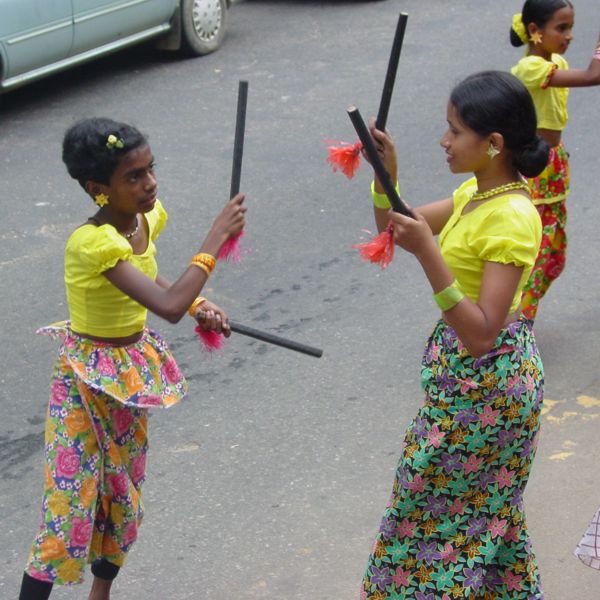 |
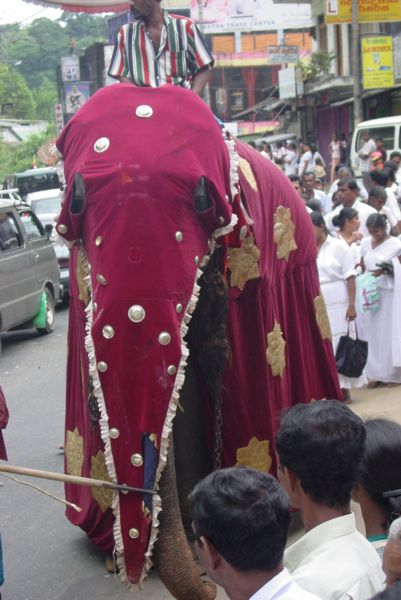 |
 |
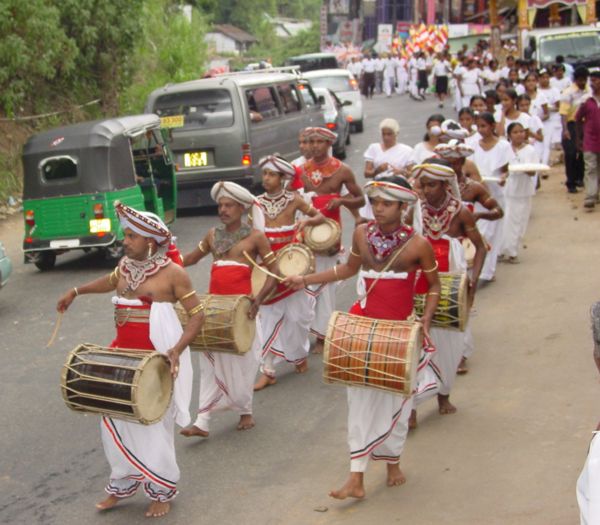 |
|
|
To see more photos of the Perahera, click here.
|
|
|
|
|
|
|
|
|
|
We persuaded Chanda to take the shorter route to Kandy, the one we use when we go to class, not realizing that it was also the procession route. We had to proceed slowly, but we got to see the whole parade again, including the elephant. The dancers had warmed up and were dancing more energetically, so we were glad to see that, as well. When we returned to the temple at six o'clock, we passed the procession yet again. They still had at least an hour to walk. The route must have been about 7 kilometers. We heard later that many of the participants were quite exhausted. We were certainly glad we hadn't waited on the street.
Our van was full for the evening. Savithri and Mr. Muneshinghe (hereafter known as Charles) joined, as well as the Muneshinghe's widowed daughter and granddaughter. In the afternoon, we had bought one hundred oil lamps (with wicks), so we needed to get coconut oil. We had brought our own bottles, a one-and-half-liter Coke bottle and a two-liter juice bottle, but the store in front of Riverdale Hotel had closed a few minutes before we got there. We had to find someplace else. Ken wondered what a coconut oil store would look like. We would soon find out. We stopped on the main street of Peradeniya and walked back to a small shop with two oil drums sitting just inside the entrance. Each had a spigot protruding from the top with a wheel and crank attached. The clerk inserted the spigot in the mouth of the bottle, turned the crank, and filled each bottle for about seventy rupees (70 cents) a liter. Ken asked whether this oil was only for burning or also for cooking, and Charles told him that it was supposed to be only for burning, but, of course, some could not afford anything else.
We had to proceed slowly to the monastery because the crowds had already started arriving. We were able to drive partway up the hill, but we had to park below the summit because the roadway (about a 45-degree incline, which some tuk-tuks cannot do) was tightly packed with pilgrims, some climbing and some placing oil lamps on the shelves lining the road. Fortunately, we were allowed to park in the VIP lot, so that we had to walk only about twenty meters up the hill. There was no room on the shelves for our lamps, so we placed as many as we could on the curb. That space was limited, however, for it was necessary to leave enough space for someone to pass through to light the lamps on the shelves perpendicular to the road.
The open area in front of the large Buddha was already packed, but we found an inconspicuous space in which to park Visakha's chair, which she occupied and watched people from. Ken and Charles took the remaining lamps and one bottle of oil and climbed toward the pagoda. Next to the stairs there was space for only a few more lamps, but the attendants were very happy to see the oil, which we gave to them. Charles took the remaining lamps (about 40) to the top (near the pagoda), and Ken went back to get the big bottle of oil. Some of the women had tried to get to the top, but had been discouraged by the crowd. By the time Ken reached the top, it was quite dark, and most of the lamps were lit. We found just enough space for all of our lamps, used up all the wicks, some in our lamps, some in others, and filled as many lamps as we could with oil. There may not have been exactly 84,000 lamps, but we can attest that there was absolutely no room for any more. The sight of all those flames was awesome. Lamps were burning in every direction. In some secluded areas, devotees had arranged the lamps to form "2550," but most impressive was seeing the entire hillside ablaze. It was dazzling! Ven. Dhammavasa had originally expected that the chanting would be completed, and that this would be the celebration of project, but there remained a little. Actually, the continuous chanting added to, rather than detracted from, the beauty and the solemnity of the occasion.
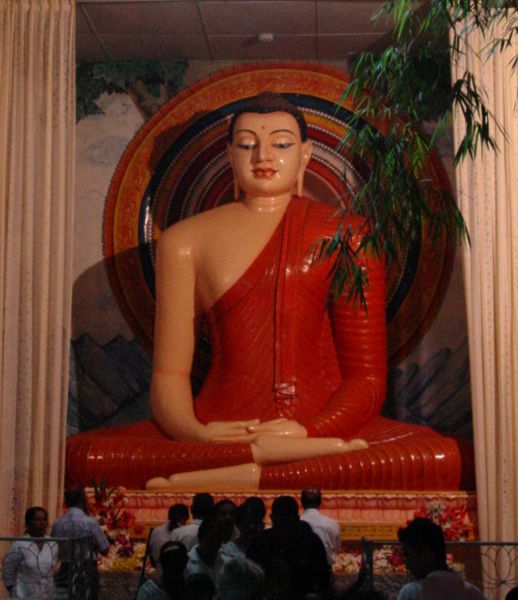 |
|
 |
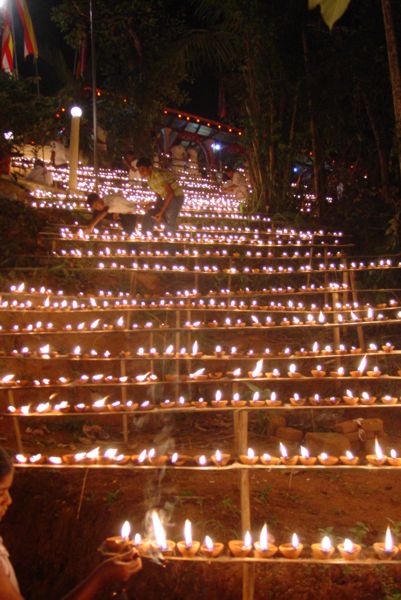 |
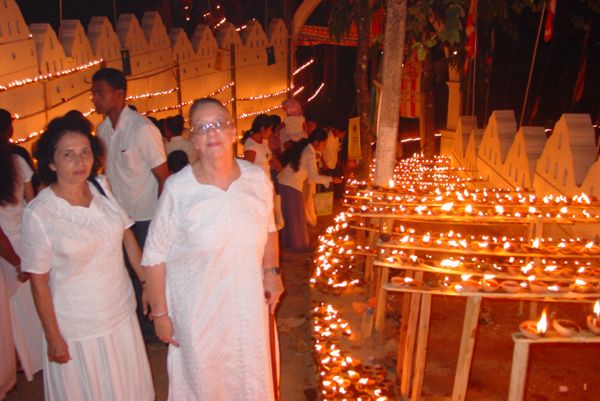 |
|
|
To see more photos of the oill lamps, click here.
|
|
|
|
|
|
|
|
|
|
As usual, Visakha enjoyed sitting reflectively, watching people. One little child spotted her, walked over while nobody was paying attention, and shyly gave her a candle. She also saw poor families, in neat but mended clothing, bringing half a liter bottle of coconut oil to offer. To them it must have been a considerable donation. Many people live only from day to day. If somebody gets sick or doesn't have work that day, the family may not eat more than rice. Ordinary people are going to face hard times as the rise in petrol prices will mean increases in everything, including staples. Where is that not true in these days? Still, the dignity and poise of all the families who came to the temple that full moon night was very beautiful. The little children's eyes grew round when they saw the splendid scene of all the lamps, and we imagine their parents told them how King Asoka's son, Ven. Mahinda, came from India and met the Sri Lankan king 2250 years ago.
The next day we offered lunch to two monks, Ven. Sathi from Triple Gem of the North in Minnesota one from Subodharama, four Americans who came with Ven. Sathi for their first visit to Sri Lanka, and two Australians, Barbara and Jackie, who are staying at Subodharama. For several of the westerners it was their first chance to offer food to monks eating from their bowls. Nice!
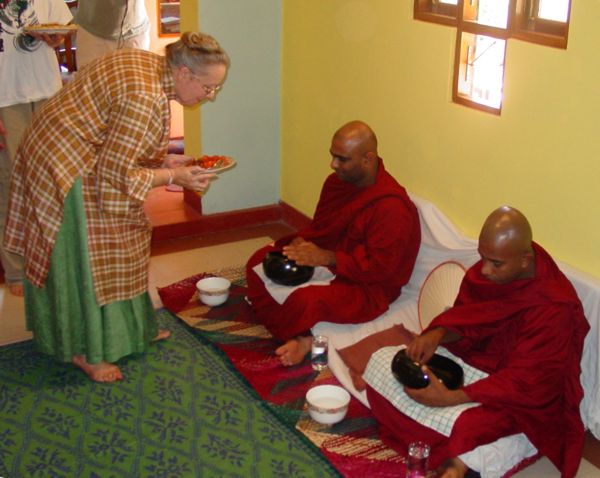 |
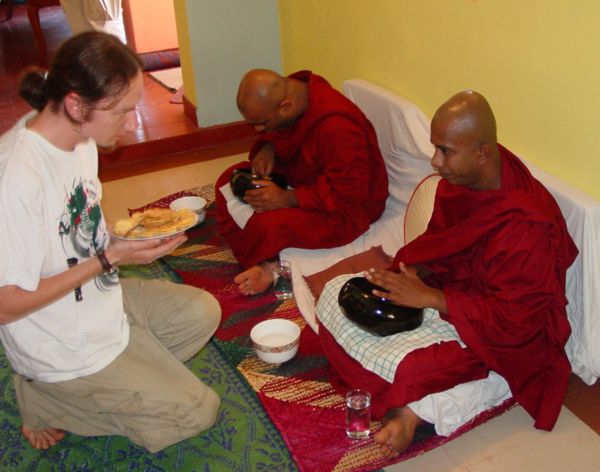 |
 |
 |
|
|
 |
 |
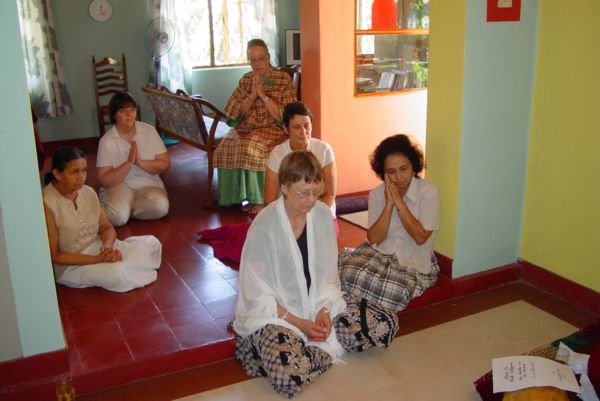 |
|
Ven. Sathi is on the left.
Ven. Nandi is on the right.
Top row, third from left, Barbara.
Center row, center photo, left, Jackie, Barbara's friend.
|
|
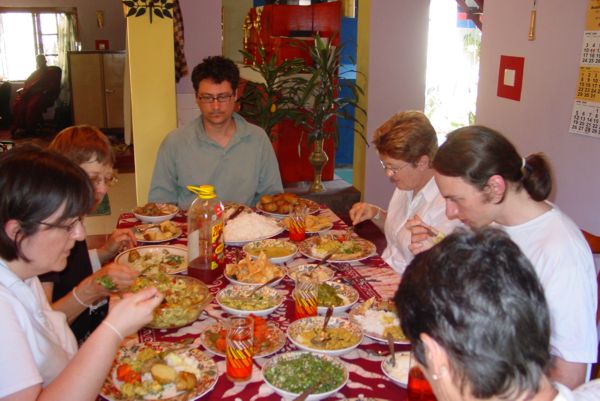 |
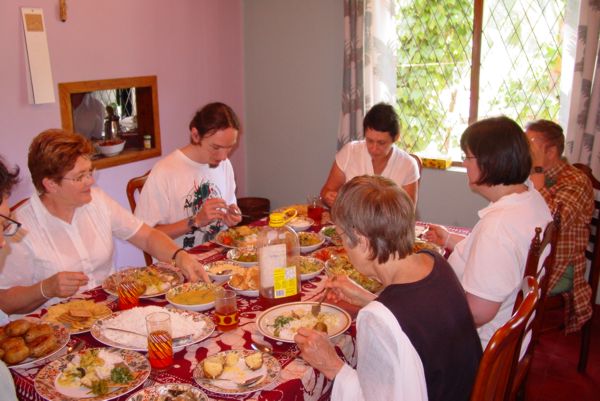 |
Center row, right photo, left, Manel; right, Savithri
Others are Ven. Sathi's students from Minnesota.
|
|
|
|
|
|
|
|
|
|
|
|
|
|
Lily watches a cooking program Sunday evenings and is trying some new dishes out on us. The most interesting was a not very sweet dessert, which we are calling Avocado Tiramisu. It;s a crumbled biscuit (that's British for "cookie") crust with an avocado/gelatin top. Since it's now the avocado season (known here as "butter fruit"!), we're going to be having that often.
 |
|
|
| Lily, her daughter and baby, Lily's husband, son-in-law, and one of their workers. |
|
|
|
|
When Savithri suggested making a proper parking place down the way, so that Manel's car wouldn't be in front of our house on the weekends, we had no idea that would mean the loss of trees and shrubs. Unfortunately, the whole project was undertaken by some lads who didn't have much of a clue what to do, and managed to make a mess of bringing down trees that had to come down on top of others that didn't. The great retaining wall is nowhere finished, and we're not sure that these workers know what they are supposed to be doing. Deep sigh!
All crows are black. Well, crows are not very observant. There's another bird, smaller than a crow, white, with red eyes, and it doesn't make a nest at all. The female lays her eggs in a handy crow's nest, and the crows do the work of warming and hatching, then feeding. Obviously, crows are color-blind and treat all the begging beaks the same. Until, that is, the white fledgling makes his distinctive uncrowlike call. Then it's war. The work of rearing done, and the interloper is kicked out of the nest.
The death of al-Zarqawi raised some interesting questions: Why not capture him alive and ask him some questions? Afraid his answers might embarrass somebody? Was it legal, dropping those two huge bombs? How do you justify the death of the little girl who was there? In Gitmo, this administration regards suicides as acts of war, aggressive attacks against the US. If they could, perhaps they'd kill them again. Someone not understanding the notion of "slippery slope" should examine the history of warfare and the hard-won international laws that were said to prevail until this Iraq War.
Our hero from Hawaii--the young officer who is refusing to go to Iraq because he refuses to be a party to war crimes. May his valiant tribe increase!
We're delighted to learn that Marsha's donation of one of her kidneys to her friend Barb was carried out successfully. It is a great thing to give the gift of life (jivitadana) Sadhu! Sadhu!! Sadhu!!!








